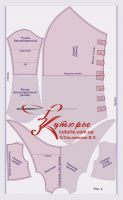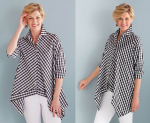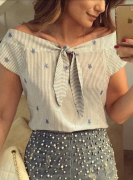Size charts What is the height of the pattern Payment methods Ask a question Reviews
PDF pattern for printing on a printer or plotter in full size for tunic sizes from 40 to 54.
Instructions on how to sew a tunic with your own hands for a pattern
Read this step by step guide:
- Description of the style and set of patterns of the tunic.
- What to sew a tunic from:
- How to cut a tunic with your own hands:
- How to sew a tunic with your own hands.
Description of the style of the tunic and a set of patterns for it
Electronic simple pattern of a trapezoid tunic with a drop.
Sizes: 40 to 54 (buyer gets all sizes).
File format for download in order:
PDF in full size and without seam allowances.
After paying for the order, you will receive links to download two files tunic patterns gradation of sizes from 40 to 54:
- PDF file A4, adapted for printing patterns on sheets of A4 paper in any program on any device, including mobile phones.
- Multi-format PDF file for printing on sheets of any size from A0 to A4 on a printer or plotter using Adobe Reader.
The level of difficulty of sewing this tunic is simple, the model is suitable for beginners learning to cut and sew. You can sew on this pattern as tunic with sleeve, and without.
 The set of patterns for a tunic-trapeze with a difference in length includes (Fig. 1):
The set of patterns for a tunic-trapeze with a difference in length includes (Fig. 1):
- Shelf pattern.
- back pattern "simple».
- Cut-off back patterns, consisting of a “bodice back” and a “skirt back”.
- Non-stop sleeve pattern.
What to sew this simple tunic from
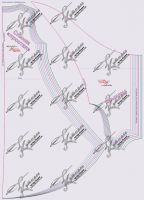
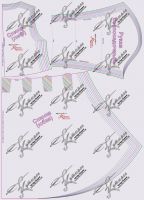 Thin and soft fabrics are suitable for sewing this tunic. For example, thin linen, staple, cambric, gauze, dress satin, poplin, silk, crepe chiffon and chiffon.
Thin and soft fabrics are suitable for sewing this tunic. For example, thin linen, staple, cambric, gauze, dress satin, poplin, silk, crepe chiffon and chiffon.
Stretch fabrics such as coolers or other thin knitwear will look good in this product.
Suitable stretch guipure and stretch soft mesh.
When choosing a fabric for this product, you should prefer a double-sided one - in which the face and inside look equally presentable.
Consumption of fabric for sewing a tunic
The fabric consumption depends on the chosen back style and sleeve length. Of course, you can also cut a sleeveless jacket.
The following is an approximate consumption of fabric with a width of 140 - 150 cm.
 A tunic with a simple back without a sleeve will need 140 - 160 cm, while with a long sleeve - 180 - 200 cm.
A tunic with a simple back without a sleeve will need 140 - 160 cm, while with a long sleeve - 180 - 200 cm.
And for a tunic with a cut-off back and without a sleeve, the consumption will increase to 220 - 230 cm, while with a long sleeve - up to 260 - 270. This is with a "skirt" cut along an oblique thread.
The style with a cut-off back and with a “skirt” cut along the transverse, the consumption ranges from 240 - 250 cm. Next, different layouts of fabrics will be considered in more detail.
How to download a tunic pattern and print it yourself
How to buy an electronic pattern
How to print a life-size pattern at home on A4 sheets
How to choose a pattern size without taking measurements and using tables
Full-size ready-made patterns free download
How to cut a tunic with your own hands according to this pattern
This style, for all its conciseness, has several features that should be understood in order to choose the desired cutting option.
Let's start the consideration, as usual, with seam allowances.
Seam allowances when cutting a tunic
For stable fabrics, allow 1 cm seam allowances at the shoulder, side, center back and "vertical" seams. sleeves.
We do not add allowances for concave and convex cuts, so as not to make them shorter.
On the bottom, add no more than 1 - 1,5 cm for a hem with an open cut, or do not add at all if we are picking or processing with a rolled seam.
When sewing stretch fabrics on an overlocker, no seam allowances are added.
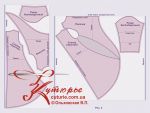 Usually I am asked why the middle seam is needed (Figure 2). It is present in this tunic for several reasons.
Usually I am asked why the middle seam is needed (Figure 2). It is present in this tunic for several reasons.
The reasons for the "simple" backrest are as follows:
- - The reason is economic - if the back is with a seam, then the consumption will be less.
- - The reason is aesthetic - if the back is made with a seam, then in stable fabrics it will be possible to avoid uneven sagging of the bottom at the back. Please note that the middle seam must be concave, that is, move away from the shared thread.
For a detachable back, a middle seam is only desirable for economic reasons (figures 3 and 4) and if it is needed to simplify the processing of the fastener. Equal is better to have parallel to the middle line.
Layouts of patterns when cutting a tunic
The traditional "jack" (see picture 1 above) is suitable for almost all types of fabrics, but the disadvantage 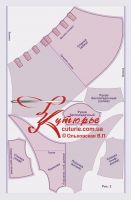 This layout is the presence of side seams that will be visible on the wrong side of the product.
This layout is the presence of side seams that will be visible on the wrong side of the product.
Help to get out of the situation sewing (linen) or double (French) stitches if you are sewing from cotton or silk fabrics.
When cutting a stretch tunic, you can cut the product without a side seam (Figure 2 above). At the same time, it is not necessary to adjust the length of the armhole of the sleeve, since the difference in the lengths of the armhole and the armhole is up to 10 cm, provided that the sleeve is non-stop.
If the backrest is detachable, then only two layout options are possible (Figures 3 and 4).
For silk and cotton fabrics, the layout option with a “oblique” skirt is more suitable (Figure 3), and for stretch fabrics, with a “transverse” skirt (Figure 4).
How to sew a tunic on a pattern with your own hands
As for sewing a tunic, special attention should be paid to the beauty of the processing of the side seams and the middle seam of the back.
Step by step instructions on how to sew for beginners:
- We process and carefully iron the middle seam and shoulder seams, while in the middle seam we process the fastener of the “spreader” type.
- We sew the sleeve without using the basting. See sewing video how to sew a sleeve without stitching
- After ironing, we process the side seams and iron again.
- It remains to try on, and then process the neck and bottom.
- The neck can be processed with an oblique inlay - This is the most suitable option for processing products made of thin fabric.
- Bottom - pick or process with a rolled seam.
See other models of women's clothing in the section of the site
Blouses patterns
Download this pattern pdf:
Pattern of a tunic-trapeze with a drop
$2.00 (80 hryvnia)
Bank cards of the Russian Federation are not accepted for payment!
Size charts What is the height of the pattern Payment methods Ask a question Reviews
Vera Olkhovskaya in social networks:

See similar clothing patterns and how to sew on them
-
Any pattern for free for a review of a previously made order
More...
Lifetime promotion for buyers of patterns!

Leave a review about my store of patterns for an order that you made before, and you will receive any paid pattern of your choice Free!

